 |
|

|
 |
TABLE of CONTENTS
 |
Newest stretch of Minnesota roadway opens with completion of final segment of Hwy 610 in Maple Grove |
By Kent Barnard, Metro District communications and engagement
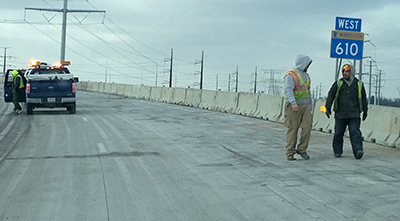
Crews prepare to open the last section of Hwy 610 Dec. 9 in Maple Grove. Photo by Kent Barnard |
Thirty years after the start of construction on a new highway across the northern Twin Cities Metro suburbs, the fifth and final segment of the long-awaited Hwy 610 Corridor officially opened to traffic at 2:35 p.m. on Friday, Dec. 9. Shortly after the final barricades and barrels were lifted from the west end of the freeway, eastbound traffic began flowing on the new 2.5 mile stretch of pavement. The westbound lanes of the freeway were opened at 3 p.m. At the same time, the interchanges at Maple Grove Parkway and County Road 81 also opened.
The final miles of roadway fills the gap between Elm Creek Blvd. and Interstate 94 in Maple Grove, allowing motorists to travel through the northern Twin Cities suburbs unimpeded between I-35W in Mounds View and I-94 in Maple Grove. Hwy 610 runs approximately 11 miles between the junction of Hwy 10 and Hwy 47 on the border of Blaine and Coon Rapids and I-94 in Maple Grove.
The $80 million expansion of Hwy 610 in Maple Grove is one of the Corridors of Commerce initiatives to reduce travel times and improve safety. It will also help businesses transport products more efficiently to meet the needs of the state’s growing economy. The new highway corridor will support economic growth and create jobs in the northwest Twin Cities suburbs.
Numerous businesses and residential developments have developed along the previously completed sections of the new highway including a new northern campus for Target Corporation along the corridor in Brooklyn Park. Additional businesses are considering the area for new developments.
Final completion of the design-build project is slated for spring 2017. Remaining work includes:
- Demolition of the 101st Ave. NE bridge in early 2017
- Transportation Management System installation
- Lighting in the County Road 81 tunnels and along the project area
- Curb, gutter and guardrail installation
- Bridge painting
- Turf re-establishment
The cities of Maple Grove and Brooklyn Park developed a comprehensive plan for the new Hwy 610 “North Crossroad” in the 1960s. The goal of the project was to provide a new northern crossing of the Twin Cities area and to relieve congestion on I-694 and I-94, a parallel route south of Hwy 610.
Planning for the original highway began in 1973 and it led to construction in segments. The first section was completed in 1986 between Hwy 252 and the junctions of Hwy 47 and Hwy 10, which included a bridge to carry traffic across the Mississippi River. The second section was built in 2000 to Hwy 10 and then to Hwy 169. The third section, in 2002, was the addition of a second Mississippi River bridge, which gave each direction of the road a four lane bridge. The fourth section was constructed in 2011 and linked Hwy 169 to Elm Creek Blvd.
Work on the fifth and final segment of Hwy 610 began in fall 2014.
“As completed,” said Bob Rabine, project supervisor, “the project realigned and extended Hwy 610 from its previous location at Hennepin County Road 81 and Elm Creek Boulevard to join I-94 in Maple Grove. There are connections from westbound Hwy 610 to westbound I-94 and from eastbound I-94 to eastbound Hwy 610. It also led to the construction of a new interchange at Hwy 610 and Maple Grove Parkway; closed and removed a half mile segment of 101st Avenue North between I-94 and Fernbrook Lane and extended 105th Ave West from Holly Lane across I-94 to a new intersection with 101st Ave.”
Future traffic projections for the road envision nearly 80,000 vehicles per day by the year 2030. The new road will support local economic development and improve the movement of freight in the region.
More information on the project is on the Hwy 610 website. |
 |
|

|
 |
TABLE of CONTENTS
 |
Research looks at new way to mitigate road construction impacts to wetlands |
By Judy Jacobs
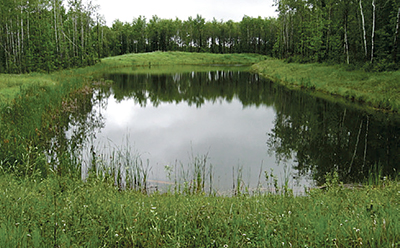
Avoiding and minimizing impacts to wetlands is given serious consideration during design and construction of transportation projects. Photo courtesy of University of Minnesota-Duluth |
Road construction in Minnesota often affects wetlands. Working in a partnership with the University of Minnesota-Duluth Natural Resources Research Unit, MnDOT’s Office of Environmental Stewardship recently studied a new method of offsetting wetland loss due to construction. They created new wetlands where none had historically existed.
In particular, MnDOT wanted to see whether abandoned borrow areas that had been excavated for road materials could adapt to high-quality wetlands with potential for plant diversity and a mix of standing waters and saturated soils that could potentially qualify for wetland conservation credit. They focused their research on 14 wetland mitigation sites along the corridor of the Hwy 53 reconstruction project, north of Virginia.
The new wetland sites were formed through the removal of borrow material for road construction. Salvaged peat and muck from several locations along the corridor were applied. Finally, wetland seeds mixes that had been approved by Minnesota state agencies were applied to each site.
The project was monitored using several techniques. Water level wells were created at each site and monitored biweekly during the growing season. Two types of plant surveys were used to determine which types of vegetation were growing. During the first two years of the study plant surveys were conducted at sample plots. The last two years of the study researchers used GPS mapping to determine the quantity and quality of each wetland’s plant community.
“The Minnesota Wetland Conservation Act requires mitigation activities in the event that road construction impacts a wetland,” said Sarma Straumanis, wetland program coordinator, Office of Environmental Stewardship. “Typically wetland restoration re-establishes former wetlands that have been drained due to construction and is the preferred mitigation practice. We thought that wetland creation shouldn’t be dismissed and wanted to investigate whether it could produce results as good as those with wetland restoration.”
The success of these sites was astounding, according to Straumanis. Establishing healthy native vegetation can be very challenging on wetland restorations, and even more difficult on wetlands built from scratch. However, many of the created wetlands on this project had higher quality native vegetation than on most wetland mitigation sites. This success is likely due to the use of “donor soil” salvaged from native wetlands that were being affected to build the road. This process not only reduced costs for hauling and disposal, but also created high quality wetland mitigation sites.
Researchers outlined recommendations for further improving the wetland sites.
“This research demonstrates that wetland creation can be successful given an appropriate landscape settings, an insightful design and an extended monitoring period,” said Ken Graeve, botanist, Office of Environmental Stewardship. “Early adaptive management on sites to regulate water levels and control invasive species is also important for successful wetland creation.”
Graeve noted that it will take some time for the research to show if this method is completely successful or not.
“The regulatory agencies require a minimum five-year monitoring period to ensure that the created wetlands meet standards,” said Graeve. “The results of this research may help guide how MnDOT addresses these situations in the future.” |
 |
|

|
 |
TABLE of CONTENTS
 |
Human Resources solicits employees interested in mobility assignments |
Permanent, full-time classified employees seeking to expand their transportation knowledge or apply existing skills in new areas of MnDOT are invited to express their interest to the Office of Human Resources by completing an online mobility application by Friday, Jan. 13, according to Karin van Dyck, HR director.
“The intent of this program is to benefit both MnDOT and employees by offering participants an opportunity to learn about the work of another area of the agency,” she said. “Broadening employees’ experiences will ultimately help MnDOT develop a talent pool for succession planning.”
HR staff is also soliciting mobility assignment opportunities from offices and districts, and will match interested employees to available assignments. The Senior Leadership Team will review information submitted by interested employees, and approve and finalize the mobility assignments.
Mobility assignments may begin as early as February 2017.
Key features of the mobility program include:
- Participation can be by self-nomination, nomination by the employee’s supervisor, or offered as a stretch assignment.
- Mobilities may involve work locations between Central Office and the districts. Expenses may be reimbursed per respective collective bargaining agreements; however, there will be no reimbursement if employees are assigned within 35 miles of their permanent work location.
- Duration of mobilities will be up to 12 months.
- A formal evaluation of the involved employees will be done both by the host and home location.
Criteria for selection:
- Minimum of two years full-time classified service at MnDOT.
- Meet current performance expectations.
- Completion of a leadership development program (MnDOT’s Leadership Development Program, Minnesota Management & Budget’s Emerging Leaders Institute and Senior Leaders Institute, etc.) or planned enrollment in LDP’s Group 8 (open for application through Jan. 13, 2017).
- Participation supported by supervisor and office director/district engineer.
|
 |
|

|
|

|
|

|
 |
TABLE of CONTENTS
 |
On the job: Ken DeCramer and his team test materials for projects in District 6 |
By Dana Hernandez
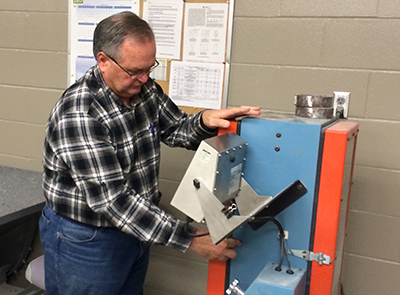
Ken DeCramer, the District 6 Materials lab manager, prepares to test a concrete cylinder in the District 6 Materials lab. Photo by Mike Dougherty |
Ken DeCramer's MnDOT career began in the District 6 surveys section in 1989. He was on the job just three weeks when he was struck by an inattentive driver and spent the next 10 days in the hospital.
That made him a little leery about working around a lot of traffic, so when he had a chance, he moved to the Materials Lab. He stayed there and today is the District 6 lab supervisor.
What kind of work is done at your facility?
We perform quality control testing for materials, such as concrete, bituminous, soils and aggregates used in concrete, bituminous and aggregate bases. These materials could be for state, county or city road/street projects and bridge projects.
District 6 has several major bridge projects in various stages including three crossing the Mississippi River. We perform testing for 12 counties, 13 cities and our MnDOT state projects. We also test salt for maintenance usage, teach technical certification classes and calibrate field/lab equipment. I spend much of my time reviewing quality reports, mix designs and material verification reports. In 2015 the District 6 Materials Lab performed more than 13,000 various tests. Our lab comes from the part of the state with less-than-good-quality aggregates. We mostly have limestone, which has more quality issues, so we have more to watch for. Basically we are testing materials to see how they will hold up in the different Minnesota seasons.
I also have the responsibility to monitor frost depths in our district.
What does a typical work day look like for you and those who work in the lab?
During construction season, I typically come in around 6 a.m. I want to make sure tests are set up for the day and priority projects are being covered. About 7 a.m. my phone starts to ring and I spend most of my day talking to field inspectors, contractors and county and city personnel on how to deal with failing or marginal material. Many times we may adjust bituminous mix designs or help them find another approved source.
The lab personnel test concrete cylinders for strength and gradations; perform magnesium sulfate tests for aggregate (testing for how it would hold up in the winter); abrasion tests to determine hardness of limestone; specific gravity/absorption tests; bituminous quality tests to see how it handles frost cycles; and tests for asphalt extraction/gradations. My crew is busy.
How many people work in the District 6 lab?
There are seven full-time technicians who work for me and in the summer we usually have one or two student workers.
What is the work load like?
The work load is gauged by how many sample tests are done in the lab. This year we performed 13,000 different tests, and that’s down from previous years. In 2013, we performed more than 16,000 tests. We have to run more quality tests in this lab because we don’t have quality material as they do in some other districts.
What do you like most about your position?
I like that every day is different because I’m dealing with state, city and county projects. I work with a range of people, such as field inspectors, contractors, project engineers, and county and city inspectors. I like that I get to work with all of them.
I do the same work as other lab supervisors. The quantity of tests we run in our lab may be more, but the tests are the same. I’ve been doing this a long time and I’m kind of the ‘old guy’ in this field, so I often get phone calls with questions that other district lab personnel might have. I really enjoy the work I do.
Do you or a co-worker have an interesting job to share with readers? Send us your ideas, and we’ll contact you for more information.
Recent employee profiles:
|
 |
|

|
 |
TABLE of CONTENTS
 |
Communication efforts receive national recognition |
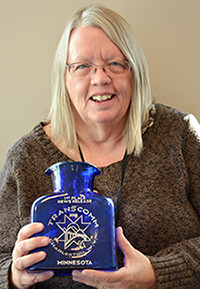
Sue Roe, Office of Communications, received a first place award in the TransComm Skills Contest for her news release about LED Lighting. Photo by Rich Kemp |
MnDOT Communications employees received two awards from the American Association of State Highway Transportation Officials' Subcommittee on Transportation Communications. The awards were presented to Sue Roe, Office of Communications and the Metro District Communications Office.
“This is a significant achievement,” said Kevin Gutknecht, Communications director. “These winners were picked from entries from across the country. And the judges are peer communications professionals from other states. It says a lot to be judged to be at the top of your game by a jury of your peers.”
Roe received a first place award in the “Skills Contest” portion of TransComm 2016, where AASHTO’s Subcommittee on Transportation Communications honored outstanding communication work from departments of transportation across the country. She received the award in the News Release category for her LED Lighting release.
Roe interviewed two traffic engineers and studied reports to get information about the lighting conversion. Following the statewide distribution of the news release, many media and industry news outlets picked up the story, including the state’s two largest dailies and more than a dozen of other print and broadcast outlets.
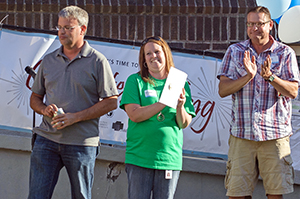
From left: Metro District employees Eric Rustad, construction; Kirsten Klein and Kevin Walker, both Communications and Engagement; helped organize the Celebrate Snelling event that won a 2016 TransComm award. Photo by David Gonzalez |
Kevin Walker and Kirsten Klein, Metro Communications and Engagement, received a second place award in the Transportation Events category for the Celebrate Snelling event.
Walker and Klein teamed with Chris Krueger, Communications and Engagement; Eric Rustad, construction; Rich Haavisto, inspector; Garret Hendrickson, inspector; and Sheila Kauppi, north area manager, to coordinate an event to thank the local businesses and residents for their patience and support during construction of Snelling Avenue near Interstate 94. More than 200 people attended the event where they enjoyed walking tours, food from local restaurants, music, kids’ activities and informational booths. This event represented the power of partnering with the community to celebrate what can be accomplished together.
The awards were announced this fall at the TransComm 2016 conference in Charleston, W.Va. |
 |
|

|
 |
TABLE of CONTENTS
 |
MnDOTís 2016 accomplishments focus on serving Minnesotans |
By Commissioner Charlie Zelle
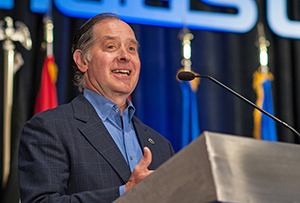
Commissioner Charlie Zelle spoke at the Mid America Association of State Transportation Officials conference in August. Photo by David Gonzalez |
As 2016 draws to a close, let me thank you all for the work you’ve done this past year to make the state’s multimodal transportation system safer and more efficient for all Minnesotans. You may work in state aid, engineering services or operations, or in modal planning and program management or corporate services, in another important area that supports MnDOT’s work. Each of us contributes to the overall success of the organization.
Below are just a few examples of the great accomplishments you’ve helped MnDOT achieve in 2016, which I also have shared with Gov. Dayton. Thank you for your contributions. We will use the momentum from these successes to achieve even more for Minnesota’s citizens in 2017.
Enhanced Public & Stakeholder Engagement
- Used extensive and innovative public and stakeholder engagement to update the four-year State Multimodal Transportation Plan and the 20-year Minnesota State Highway Investment Plan. MnDOT collected more than 12,450 responses from Minnesotans who closely mirrored statewide gender, race/ethnicity, age and geographic demographics. This is more than twice as many citizens and stakeholders reached in previous plan updates. The team used plain language and ensured accessibility throughout the process. These plans received a Minnesota State Government Innovation Award and an Excellence in Community Engagement award from the Upper Midwest American Planning Association.
- Generated a great deal of public participation and engagement in MnDOT projects. For example, Metro District’s largest such effort is the Rethinking I-94 project, which held individual and group meetings with more than 275 different community groups and neighborhood organizations and individuals. The effort also engaged a variety of community groups and businesses through a partnership with the Urban Land Institute and one of their Technical Assistance Panels. Based on the partnerships in place for this effort, Minnesota last summer was selected as one of four regions across the country for a USDOT Every Place Counts Design challenge workshop, which involved local residents in creating ideas for improving the health, mobility, access and prosperity of their communities.
- Reviewed and updated the Cost Participation Policy to minimize the local cost share of cooperative trunk highway construction projects while complying with the state constitution. The process included consulting with local agencies and internal MnDOT stakeholders. The results helped shape the updated policy philosophy and provided recommendations for policy change and process improvements as well as identifying issues needing further study.
- Developed and implemented a public engagement policy to increase agency transparency and collaboration and to ensure everyone has the opportunity to participate in MnDOT’s public processes.
- Developed and began implementing a strategic plan for aviation education, public engagement, outreach and marketing activities.
Improved Sustainability & the Environment
- Established Interstate 35 as the Monarch Highway with five other states to improve pollinator habitat along this key migratory corridor for monarch butterflies.
- Began switching highway lighting in the Metro District from high pressure sodium to Light Emitting Diodes. The effort, which is more than 90 percent complete, will save on utility and maintenance costs because LED lighting lasts longer and uses less energy. MnDOT has and will receive rebates from the power company for the switch to LEDs.
- Received a Federal Highway Administration designation for I-94 as an alternative fuel corridor. The program will promote alternative fuels and help motorists find electric vehicle charging stations nationwide.
Gained Greater Efficiency in Operations
- Implemented new Shared Services program in the Office of Land Management to assist districts in delivering appraisal, direct purchase and relocation functions. Also implemented a Shared Services program in intelligent transportation systems design, traffic signal and lighting design, and signing design.
- Formed the National Road Research Alliance with six other states and 20 associate members. The goal of NRRA is to help agencies across the country benefit from road research. It will also provide industry and academia a place to evaluate pavement technologies. It is a pooled fund group and MnDOT provides administration for the alliance.
Efficient Execution of Roadway Program
- Completed a number of projects during the 2016 construction season, including bridge projects on I-90, between La Crosse, Wis., and La Crescent, Minn., and on Hwy 43 in Winona; significant road rehabilitation and expansion projects on I-494 in Plymouth, Hwy 100 through St. Louis Park, and the Hwy 610 extension from Elm Creek Blvd to I-94 in the northwest Twin Cities metro area. In addition, our crews in District 7 completed a project on Hwy 169 that raised the roadway in flood-prone areas and completed expansion of Hwy 14 to four lanes from North Mankato to Nicollet.
Advanced Key Multimodal Programs
- Minnesota was once again named the second most bike friendly state by the League of American Cyclists. And the FHWA designated Minnesota’s second US Bike Route, USBR 41, which runs from St Paul to Canada via Duluth and the North Shore of Lake Superior.
- Rehabilitated four truck fixed weigh scales around the state. These are used for weight enforcement by the State Patrol to ensure trucks comply with state truck weight provisions. Managing truck weight is necessary to preserve road and bridge infrastructure.
- Completed construction projects with the St Paul Port Authority and Duluth Seaway Port Authority that increase capacity and capability. The projects added heavy-lift and roll-on/roll-off capabilities in Duluth and heavy-lift capabilities in St. Paul.
- Completed the State Freight Plan, which established strategies to improve the performance of the state’s multimodal freight transportation system.
- Continued to develop the proposed Northern Lights high-speed rail line and the second Amtrak train to Chicago passenger rail projects.
- Completed the Statewide Bicycle System Plan, which promotes MnDOT’s vision and goals for bicycle transportation, implementation strategies and performance measures. The plan works to make bicycling safe, comfortable and convenient for all people. MnDOT districts will add to this plan with specific plans for their regions.
- Received a federal grant to update the Statewide Aviation System Plan.
Established Bi-partisan Recognition of Need for Transportation Funding
- Conducted a substantial public outreach effort to promote an increase in transportation funding in conjunction with Gov. Dayton. This led to broad, bi-partisan recognition of the need for the increase in funding; MnDOT’s latest planning documents show a gap of $18 billion over the next 20 years between what is needed to maintain the transportation system and the revenue the state is forecasted to receive.
Advancing Diversity & Inclusion
- Conducted listening sessions across the department to gather suggestions on how to ensure MnDOT is fostering an inclusive environment, and to shed light on barriers to inclusivity. MnDOT’s Diversity and Inclusion Committees are shaping the next two years of their work plans based on this input.
- Established seven employee resource groups to bring together people from traditionally underrepresented groups. These ERGs support their members in professional development, recruitment, retention and community outreach.
- Established an ERG rotation program that allows members of the ERGs to gain work experience in other areas at MnDOT. Rotations last anywhere from a few weeks to a year and provide experience in other areas of MnDOT that can serve in career development.
- Received recognition for MnDOT’s Metro District for its diversity efforts in hiring practices.
- Continued support of the state’s Government-to-Government Tribal-State Relations training program. The MnDOT-run program received a 2016 Minnesota State Government Innovation award.
Strengthening Safety
- Worked on 14 railroad grade crossing safety projects on the crude-by-rail freight train corridors.
- Added left turn lanes and a concrete media barrier to Hwy 12 in Independence, an area prone to cross-median crashes.
- Installed 50 new miles of cable median barrier. Nearly 600 miles of state roadway now have cable median barrier.
- Continued to fully participate with the Toward Zero Deaths effort and its goal of reducing traffic fatalities on Minnesota roadways to 300 or fewer by 2020.
Progressing in Asset Management
- Completed implementation of an enterprise–wide asset management system for signals, lighting and intelligent transportation systems equipment and a number of other devices valued at $725 million.
Improving Data and Knowledge Management
- Completed a major database upgrade project, replacing the decades-old Transportation Information System with the modern Linear Referencing System. The LRS provides the backbone of a database that links roadway data to a location on the trunk highway system allowing MnDOT to better monitor and report on the trunk highway system’s condition.
Editors note: In the next issue of Newsline, Commissioner Zelle will talk about MnDOT's goals for 2017. |
 |
|
| |
|



